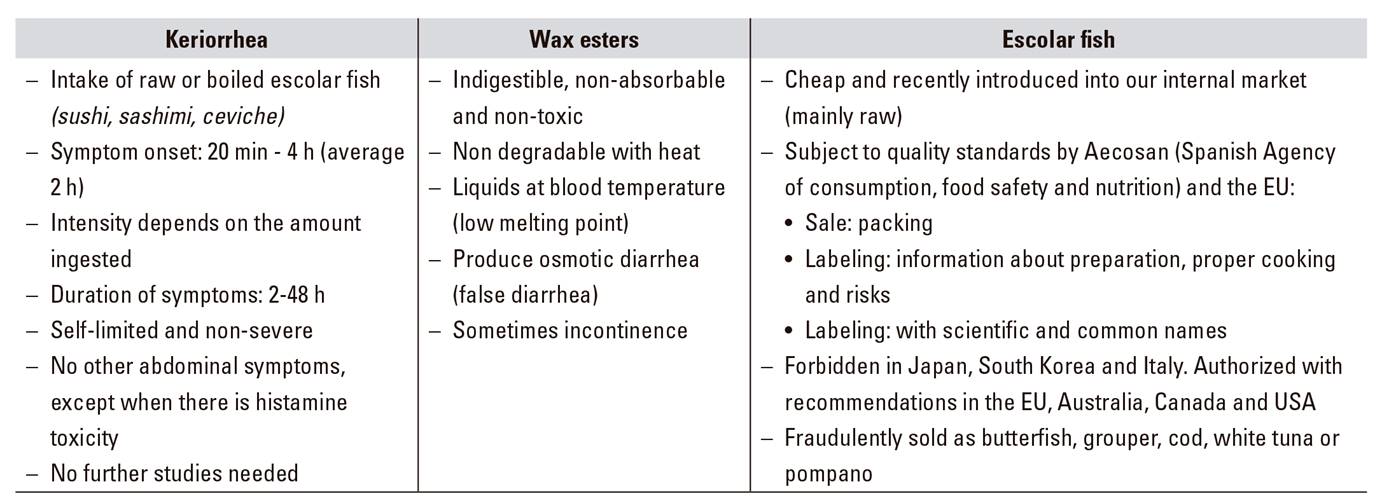Mi SciELO
Servicios Personalizados
Revista
Articulo
Indicadores
-
 Citado por SciELO
Citado por SciELO -
 Accesos
Accesos
Links relacionados
-
 Citado por Google
Citado por Google -
 Similares en
SciELO
Similares en
SciELO -
 Similares en Google
Similares en Google
Compartir
Revista Española de Enfermedades Digestivas
versión impresa ISSN 1130-0108
Rev. esp. enferm. dig. vol.110 no.8 Madrid ago. 2018
https://dx.doi.org/10.17235/reed.2018.5614/2018
SCIENTIFIC LETTERS
Keriorrhea (waxy diarrhea), a new sign to bear in mind
1Servicio de Aparato Digestivo. Hospital Virgen de las Nieves. Granada, Spain
Key words: Keriorrhea,Waxy diarrhea; Orange stools
Dear Editor,
We have recently treated three patients with keriorrhea and would like to make a few comments. The cases were two females and a male aged 44, 28 and 49 years old, respectively. They were concerned due to the presence of one to three orange oily-mucous bowel movements, with or without feces. This only lasted 24-72 hours in all cases until regular bowel movements were recovered. There was no history of abdominal symptoms, rash or fever.
Until recently, this kind of event was very unusual in our country. However, it has become more frequent due to the increased ingestion of poorly cooked or raw food (sushi, sashimi, ceviche, etc.) 1,2,3 during the last decade. All our patients mentioned a recent intake of raw fish, which also occurred when this phenomenon was first described 4. The ingested fish belonged to the Gempylidae family (Lepidocybium flavobrunneum and Ruvettus pretiosus), also known as escolars and incorrectly classified as butterfish. Almost 20% of their weight is made of indigestible and non-absorbable wax esters or gempylotoxins (there is no specific lipase). Once inside the colon, they produce an osmotic laxative action and false diarrhea, with or without incontinence 5 (Table 1). A similar outcome occurs with the drug Orlistat(r), when lipases are inhibited and induce steatorrhea. The histidine originated from an incorrectly preserved fish which is transformed by the intestinal microbiota into histamine 3. Thus, this manifestation is sometimes accompanied by histamine toxicity symptoms, such as a headache, rash, abdominal pain or sweating.
These are non-severe and self-limited symptoms which concern patients. It is important to know and identify this kind of condition in order to avoid inappropriate, expensive and unnecessary diagnostic tests.
Bibliografía
1. Martín Granado A, Varela Martínez MC, Martínez Sánchez EV, et al. Interés de la identificación de la especie de pescado en brotes de diarrea oleosa con heces anaranjadas. Bol Epidemiol Sem 2007;15:25-36. [ Links ]
2. Caro Rebollo J, Cosculluela Aisa M, Beltrán Lacort F, et al. Oily orange diarrhoea. Fish-induced keriorrhoea. An Pediatr (Barc) 2011;74:67-8. DOI: 10.1016/j.anpedi.2010.09.023 [ Links ]
3. Fariñas Cabrero MA, Berbel Hernández C, Allué Tango M, et al. Brote epidémico por consumo de pez mantequilla: keriorrea e intoxicación histamínica. Rev Esp Salud Pública 2015;89:99-105. DOI: 10.4321/S1135-57272015000100011 [ Links ]
4. Berman P, Harley EH, Spark AA. Keriorrhoea - The passage of oil per rectum after ingestion of marine wax esters. S Afr Med J 1981;59:791-2. [ Links ]
5. Robles I, Vásquez JM, Loehnert R, et al. Orange oily anal leakage: a new entity linked to dietary changes. Gastroenterol Hepatol 2012;35:74-7. DOI: 10.1016/j.gastrohep.2011.11.009 [ Links ]











 texto en
texto en 



